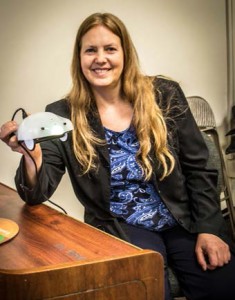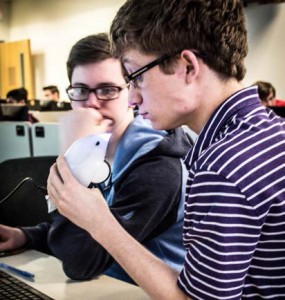Visiting assistant professor Kristin Pepper uses robots to help her engage her students while they learn to code.

Prof. Kristin Pepper with Finch—a robot the size of your hand
By Mattia Ciurlino
Writing algorithms and code are the most essential tasks in computer science and in developing and maintaining software. It’s adventurous work but learning it can be tedious.
So how do you keep students engaged?
Just bring in a robot.
That’s what Kristin Pepper, a visiting assistant professor, did last fall when she introduced Finch—a robot the size of your hand that looks like a stingray—to her Introduction to Computer Programming course. Her innovative approach promoted interactive learning, where students write code and algorithms that instruct Finch, which then performs tasks based on the students’ work.
“If you can get students to play with their work and turn it into something fun, they will spend more time doing it,” Pepper said. “They will become better coders.

Students contemplate Finch while learning to code.
“Finch can speak, buzz and make a few sounds,” she explained. “His little nose and eyes have a sensor of position so that he sees whether he is about to hit something, even though he is not so good at it. He can see on the right and on the left, identify the temperature, and he knows his orientation, thanks to a three-axis accelerometer, which works pretty much the same way as a Wii remote controller.”
The product of a four-year study at Carnegie Mellon’s CREATE lab, Finch avoids obstacles, reacts to lights and turns on a dime. Pepper purchased the first robot on her own and seeing how it energized her students has made it a staple in the classroom. The department is now the proud owner of 10 Finch robots making regular appearances in classes and at meetings of the Robotics Club, which Pepper started in Fall 2014.
“I do think computer scientists needing to work with robotics is becoming more prevalent in the workplace,” she said. “Robotics will be helpful to the students to visualize how their programs work with moving hardware.”
This article appeared in the Spring 2015 edition of The Catalyst, the College of Arts and Sciences newsletter.